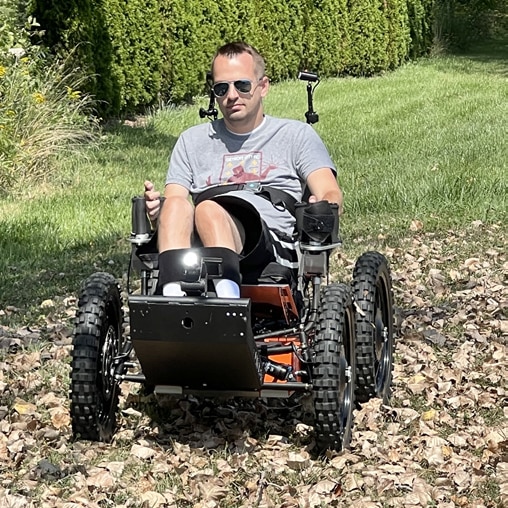November 1, 2022

I’m always intrigued when I see other wheelers barrel through the woods or tackle rough surfaces in all-terrain chairs, but I didn’t know what it felt like until I reviewed Outrider’s new accessible off-road vehicle, the Coyote 4WD.
After hours testing the Coyote in every set of conditions I could imagine, two feelings jumped out at me: freedom, for being able to go almost anywhere I wanted, and appreciation, for empowering me to do something new.
The Outrider Coyote is an electric off-road vehicle designed for people with disabilities. The demo model that I received included a ROHO cushion, a lap belt, a chest strap, a strap to secure my legs, and several other straps that I did not need.
The hand controls came with a tri-pin adapter so I could use the throttle and steer safely. Two buttons that allow you to change gears and speeds, among other functions, are attached to arms that are mounted behind the driver seat. The arms adjust so you can press the buttons with your shoulders or head without removing your hands from the hand controls. Finally, the seat is adjustable to accommodate height and arm length, and the back angle is adjustable for comfort and balance.
The hardest part of using the Coyote for me was transferring to it. As a C5-6 quad with no triceps and terrible balance, transferring to anything is difficult for me. The frame of the Coyote does not allow you to get very close to the seat, so there is a considerable gap to transfer over. No doubt someone with more function and balance could transfer with a sliding board, but I couldn’t. Once in the seat, you have to swing your legs over the throttle control and into the footrests. Fortunately, my brother and caregiver were available to lift me from my wheelchair to the Coyote. It was an awkward transfer, but we got it done.
Adaptable Driving

Driving the Coyote is straightforward. Two hand controls, one on each side, control the steering and the throttle. The Coyote can be customized to accommodate differences in strength between your arms. My left arm is stronger than my right arm, so for my setup, the steering control was on the left and the throttle on the right.
To steer the Coyote, I pushed the left handle forward to turn right and pulled back on it to turn left. It does take a fair amount of strength to be able to steer, so I needed to use an adaptive grip to keep my hand on the handle. The throttle is controlled by tipping the handle back and forward. Tipping the handle back accelerates while tipping forward engages the brakes.
The Coyote has three speed modes, with top speeds of 6, 10, and 22 mph. I did not feel like I had the strength to control the Coyote at higher speeds, so I never tried it higher than 6 mph. The acceleration can be a little jumpy, but after some practice, I got used to it. The throttle can be adjusted to make it less jumpy, but since I only had a demo unit and my time was limited, I left it as it was delivered. My brother, who is nondisabled, was able to handle the Coyote easily at 10 mph, but even he felt like 22 mph was a bit too much. If you’re trying it out, start slow and make sure you have the function to handle it at higher speeds.
Performance-wise, the Coyote did a great job handling different types of terrain. I have never used an off-road vehicle before, so I have nothing to compare it to, but the ride was very smooth. I tested it on grass, dirt and concrete, and going up and down hillsides. The Coyote managed everything with ease. I don’t have trunk control, so it was difficult for me to maintain my balance while driving on the side of a hill. The Coyote never felt in danger of tipping over, though, and I always felt secure and safe in the driver’s seat except when angled on a hill.
Transporting and Takeaways
Transporting the Coyote could be an issue for those without access to the right type of vehicle. At 78 inches long, 33 inches wide and up to 36 inches tall, it can weigh up to 250 pounds, depending on the options added. The model I demoed fit into the back of a pickup truck with the gate open. We secured it with tiedowns. It took two people to lift the Coyote into the bed of the truck, but despite its weight, this was not difficult. The Coyote would likely fit in the back of most minivans and larger SUVs with the rear seats removed.
The Coyote starts at a base price of $13,985. Options are extra. It comes standard with one rechargeable lithium-ion battery with a top range of 35 miles. Up to three additional batteries can be added at any time for a top range of 140 miles. Customers can choose from two different 2WD powertrains and one 4WD powertrain. Additional options like a cargo rack or electronics package can be added as well.
The Outrider Coyote is a great product for those looking to get back into nature, whether it’s hunting, fishing or trail riding. It would also be useful for somebody who lives on acreage and needs to get around their property quickly. It is expensive, so I would recommend going for an extensive test ride to be sure you can control it and be comfortable in it for extended periods of time. For more information and to see the full selection of Outrider models, visit outriderusa.com.
